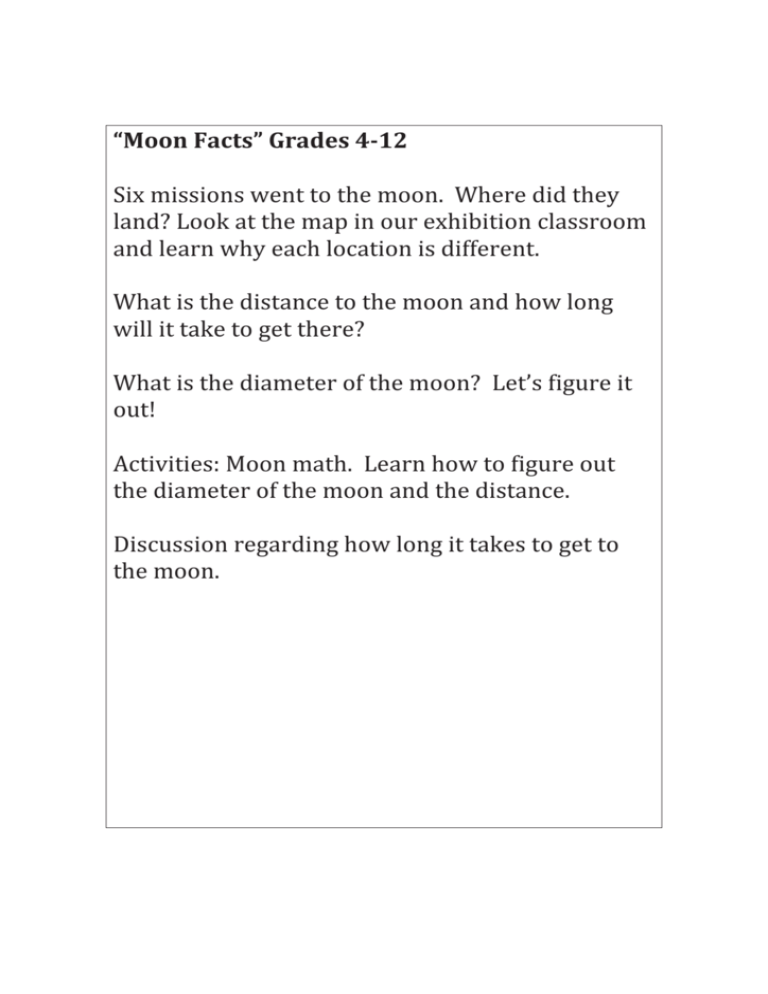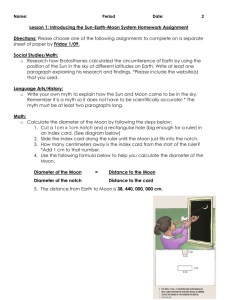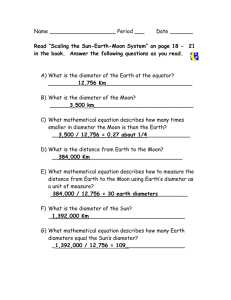Exploring the Moon pdf
advertisement

" " "# ! Unit 1 Pre-Apollo Activities Distance to the Moon Diameter of the Moon Reaping Rocks Before Apollo 11 astronauts Neil A. Armstrong and Edwin E. “Buzz” Aldrin Jr. stepped on the Moon on July 20, 1969, people had studied the Moon by eye, telescope, and images from spacecraft. The theme of Unit 1 is a basic introduction to the Moon -- how it looks from Earth, how far away it is, and how big it is. The activities allow students to make comparisons between the Moon and Earth as well as to make predictions about the Moon rocks. Encourage students to sketch and describe nightly observations of the Moon and keep a written record of date and time. Nightly charting of the Moon helps students recognize Moon phases as well as the bright and dark terrains. Scale models and proportional relationships are featured in the first two activities. The “Distance to the Moon” and “Diameter of the Moon” activities introduce students to techniques of measuring distances in space indirectly. This unit also includes an activity to collect and study rocks called “Reaping Rocks.” This activity should follow a more comprehensive lesson on basic rock and mineral identification. The activity also extends learning to the Moon and asks students to predict how their rock collections will compare with lunar samples. A Resource Section for Unit 1 is on Page 24. Exploring the Moon -- A Teacher's Guide with Activities, NASA EG-1997-10-116-HQ 23 Unit 1 Resource Section This list presents possible independent and commercial sources of items to complement the activities in Unit 1. The sources are offered without recommendation or endorsement by NASA. Inquiries should be made directly to the appropriate source to determine availability, cost, and ordering information before sending money. Contact your NASA Educator Resource Center (see Page 146) for more lists of resources available directly from the National Aeronautics and Space Administration. Maps The Earth's Moon by National Geographic Society. Wall map showing nearside and farside. Also includes graphics with captions explaining eclipses, lunar phases, tides, and other phenomena. U.S. and Soviet landing/impact sites are shown. The reverse side has an index of lunar named features and selected photographs from the Apollo missions. National Geographic Society Educational Services, Department 91 Washington, D.C. 20036 1-800-368-2728 or FAX 1-301-921-1575 Giant Moon Map by Rand McNally. Wall map showing the nearside. Contact Rand McNally directly, or order it through: Astronomical Society of the Pacific 390 Ashton Ave. San Francisco, CA 94112 1-415-337-2624 Maps of Earth, Moon, Mars, etc. U.S. Geological Survey Map Sales Box 25286 Denver Federal Center Denver, CO 80225 303-236-7477 (Ask for Customer Service) Globes Edmund Scientific Co. 101 E. Gloucester Pike Barrington, NJ 08007-1380 1-609-573-6270 or FAX 1-609-573-6295 24 Lunar Phase Calendars Celestial Products P.O. Box 801 Middleburg, VA 22117 1-800-235-3783 or FAX 1-703-338-4042 Earth Rock Sample Sets Ward's Natural Science Establishment, Inc. P.O. Box 92912 Rochester, NY 14692-9012 1-800-962-2660 Slides Glorious Eclipses slide set Astronomical Society of the Pacific 390 Ashton Ave. San Francisco, CA 94112 1-415-337-2624 Other Teacher's Guides Exploring Meteorite Mysteries: Teacher's Guide with Activities, NASA EG-1997-08-104-HQ. M. Lindstrom et. al., 1997 Companion volume available from NASA Educator Resource Centers or CORE (refer to Page 146 of this book.) Return to the Moon: Moon Activities Teacher's Guide, 1990 Challenger Center for Space Science Education 1101 King Street, Suite 190 Alexandria, VA 22314 1-703-683-9740 Exploring the Moon -- A Teacher's Guide with Activities, NASA EG-1997-10-116-HQ Teacher Page Distance to the Moon Using this scale, the basketball-tennis ball separation in centimeters (x) is derived: x = 382,500 km = 719.7 cm 531.5 km The value x may be rounded to 720 cm and converted to meters so that the students need to place the basketball and tennis ball 7.2 m apart. Preparation Review and prepare materials listed on the student sheet. If it is not possible to obtain an official-size basketball and tennis ball, then you can use other spherical objects or circles drawn on paper. Clay balls may be used as models. For example, for two clay balls, 10 cm diameter and 2.7 cm diameter, the scale is 1 cm = 1,275.6 km. At this scale, students need to separate the clay balls by 3 m. In Class Divide the students into cooperative groups. Students must keep track of units of measure. Wrap Up Did the students have an accurate idea of the size relationship between Earth and the Moon before doing this activity? Did the effect of separating the scale models help them visualize the distance to the Moon? Extensions 1. How long did it take Apollo astronauts to travel to the Moon? 2. Have students measure the circumferences of various spheres so that each group uses a different pair of models. 3. Instead of using the average distance to the Moon, use the distance from July 20, 1969, to recall the Apollo 11 landing or use the distance for today. 26 Exploring the Moon -- A Teacher's Guide with Activities, NASA EG-1997-10-116-HQ Distance to the Moon Purpose To calculate the distance between scale models of Earth and the Moon. Key Word Procedure scale 1. If Earth were the size of an official basketball, then the Moon would be the size of: another basketball? soccer ball? baseball? tennis ball? golf ball? marble? Materials “Moon ABCs Fact Sheet” sports balls calculator meter tape 2. The diameter of Earth in kilometers is: 3. The diameter of the Moon in kilometers is: 4. What percentage of Earth's diameter is the Moon's diameter? 5. Use the list below to change or confirm your answer to Question 1. official basketball size 5 soccer ball official baseball tennis ball golf ball marble diameter in cm 24 22 7.3 6.9 4.3 0.6 If Earth is a basketball, then the Moon is a: Exploring the Moon -- A Teacher's Guide with Activities, NASA EG-1997-10-116-HQ 27 Distance to the Moon 6. Use an official basketball as a model of Earth. Use a second ball, the one you determined from Question 5, as a model of the Moon. 7. Determine the scale of your model system by setting the diameter of the basketball equal to the diameter of Earth. cm = km therefore, 1 cm = km 8. If the distance to the Moon from Earth is 382,500 km, then how far apart must you separate the two scale models to accurately depict the Earth/Moon system? Using the scale value in the box from Step 7, the model separation in centimeters (x) is derived: x = actual distance to the Moon in kilometers scale value in kilometers x = x = centimeters The two scale models must be separated by meters. 9. Set up your scale model of the Earth/Moon system. Does it fit in your classroom? 28 Exploring the Moon -- A Teacher's Guide with Activities, NASA EG-1997-10-116-HQ Teacher Page Diameter of the Moon Purpose To calculate the diameter of the Moon using proportions. Background The diameter of the Moon is proportional to the diameter of a cardboard disk, given that you know the distance to the Moon and the distance to the cardboard disk. The relationship is: d l D L so that: D = L(d/l) where D d L l = diameter of Moon = diameter of cardboard disk = distance to Moon = distance to cardboard disk In this activity, students will measure d and l. They will be given L. They will calculate D. The diameter of the Moon (D) is 3,476 km. Preparation Review and prepare materials listed on the student sheet. Choose a day and location for this activity which is best for viewing a full Moon. A cardboard disk of 2 cm diameter works well. Better accuracy may be achieved by using a larger disk, thus a greater distance l. However, if obtaining or cutting cardboard is difficult, then this activity can also be done with dimes. A dime held out at arm's length will cover the Moon. The distance from Earth to the Moon for a given date can be obtained by asking a local planetarium staff, Or for this activity, students may use an average value of 382,500 km. Exploring the Moon -- A Teacher's Guide with Activities, NASA EG-1997-10-116-HQ 29 Teacher Page Diameter of the Moon In Class If students work in pairs, then one student can use the string to measure distance from their partner's eye to the disk. The same units do not have to be used on both sides of the equation, but d and l have to be the same units. The D will be the same unit as L. Wrap-Up To compute the density of the Moon use the diameter to compute volume and use the mass value of 7.35 x 1022 kg. Density of the Moon is 3.34 grams/cubic cm. 30 Exploring the Moon -- A Teacher's Guide with Activities, NASA EG-1997-10-116-HQ Diameter of the Moon Purpose To calculate the diameter of the Moon using proportions. Key Words Procedure proportional 1. On a day when you can see the Moon: place a cardboard disk on top of a stake or on a window sill so that it exactly covers the Moon from your point of view behind the cardboard disk. Materials 2-cm wide cardboard disk wooden stake (optional) meter stick calculator string 2. Have a friend measure the distance from your eye to the cardboard disk. Call this distance l and write the value here: l= 3. The distance from Earth to the Moon varies between 360,000 km and 405,000 km. Find the distance for today’s date or use an average value for your calculations of 382,500 km. Write the value that you are going to use here: L= 4. What is the diameter of the cardboard disk? d= 5. The diameter of the Moon is proportional to the diameter of your cardboard disk by this equation: d D l L where: D d L l so that, D = L(d/l) = diameter of Moon = diameter of cardboard disk = distance to Moon = distance to cardboard disk Exploring the Moon -- A Teacher's Guide with Activities, NASA EG-1997-10-116-HQ 31 Diameter of the Moon Results 1. By your calculations, the diameter of the Moon is: D= 2. Compare your result with the accepted diameter of the Moon. How close did you get? 3. How many times smaller is the diameter of the Moon than the diameter of Earth? 4. When you calculated the diameter of the Moon, did you have to use the same units on both sides of the equation? 5. How and where could you find the value for the distance to the Moon for today's date? 6. What else would you need to know to compute the density of the Moon? Try it. 32 Exploring the Moon -- A Teacher's Guide with Activities, NASA EG-1997-10-116-HQ








